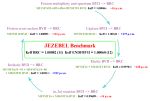EPJ A Review - Coherent Investigation of Nuclear Data at CEA DAM: Theoretical Models, Experiments, and Evaluated Data
- Details
- Published on 21 October 2012

Dr. Eric Bauge et al describe a body of work accomplished by the CEA/DAM. Their goal is to determine accurate nuclear reaction cross sections for use in neutron transport codes. This work integrates theory and modeling, experiment, computer simulation, and statistical analysis. It involves researchers who thrive on multidisciplinary work, and who are motivated to achieve realistic simulation predictions in nuclear technology applications. Not only has the group succeeded in creating databases of accurate cross sections, but in every aspect of the work significant progress has been made in advancing our understanding of the underlying nuclear physics.
The article provides a unique analysis of advances in applied nuclear reaction physics, including, notably: (1) Fission and inelastic scattering using detailed nuclear structure descriptions of actinides; (2) Integral simulations of critical assemblies that reveal compensating errors between different reaction channels (Fig. 1) – this CEA discovery is now motivating the broader community to identify and eliminate deficiencies; (3) Identification of limitations on the applicability of the surrogate method for neutron capture.
CEA/DAM contributes to the Joint Evaluated Fusion and Fission File (JEFF3.1), the database that is used widely in European nuclear technologies. They collaborate closely with related efforts in the USA (ENDF/B-VII) and Japan (JENDL).
The authors show useful comparisons of their work against those based on ENDF/B-VII.0 and JENDL3.3-08, demonstrating the quality of these various capabilities. CEA/DAM strengths lie, in particular, in bringing microscopic theoretical insights in fission, coupled-channel optical model, and inelastic scattering to advance the quality of their application nuclear databases.
Coherent investigation of nuclear data at CEA DAM: Theoretical models, experiments and evaluated data. E. Bauge et al., Eur. Phys. J. A (2012) 48:113





